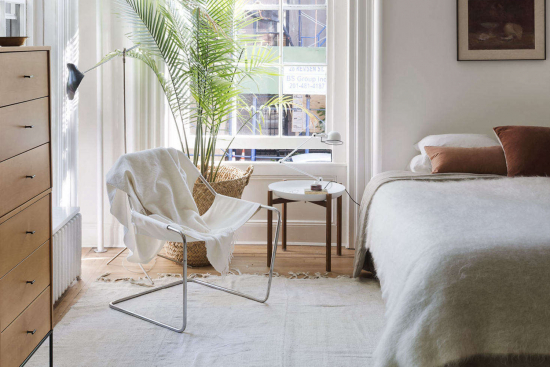Remodeling 101: The Case for Unstained Wood Floors, from a Stealth Design Nerd
Editor’s note: This is the first in a series of posts by Sally Kohn— journalist and CNN political commentator, TED talk giver, and design aficionado—chronicling her adventures in remodeling.

It started with too much dark wood. The house we bought—a late 1700s bank barn which had been converted into a house in the 1950s with the help of famous woodworker Wharton Esherick—had, as you might imagine, a lot of dark wood. Dark wood beams. Dark wood bookcases. Dark wood cabinets and railings. And dark wood floors. And despite the soaring ceilings and the fact that it was, without a doubt, more spacious than the Brooklyn, New York, apartment from which we were moving, all that dark wood felt like a lot for our fairly modernist, minimalist design sensibilities. But what could be done? We figured a fresh coat of paint and more upholstered furniture than wood furniture was our best hope.

Then I saw the raw wood floors. I’d never refinished floors, so I didn’t understand that when you sand them down, they don’t retain the coloration of the stain. Rather, and certainly in our case, where the floors hadn’t been refinished in decades, when I showed up on a June morning to pick out stain colors for our newly refinished floors, I was shocked to see what looked like brand new flooring. It felt like stepping into an alternate universe. Like someone had gone to the top of a mountain somewhere in the pristine Pacific Northwest (I’m not at all sure that’s where our floors are from, probably not, but I imagine that all of the prettiest wood comes from there) and laid virgin blonde hardwood afresh below our bare feet. It was stunning. And alongside the fresh coat of white paint (thank you Lick White 07 Matt) the whole house just looked clean and bright and stunning.
And then I was supposed to pick a stain to darken the floors again? I picked one, thanked my wonderful Bucks County, Pennsylvania, floor guy—the great Michael Biafore—and drove back to New York. And then it hit me. Why do we have to stain them darker? Can’t we just leave them bright and clean and light?

That’s just what we did. Mike applied a coat of Bona’s Natural Seal to seal the floor—turns out that stain also serves the purpose of sealing, so we needed something clear that would serve that purpose. And then we protected it with a few coats of Bona’s Traffic HD in Extra Matte. The results are even better than I imagined—and create a very sophisticated, Scandinavian look, the light floors juxtaposed against all the dark artful Esherick woodwork.

My only concern, at the time, was that we had just bought a sofa with light-wood legs and a light-wood dining table, thinking that it would be necessary against the dark flooring. But the good news is that the “honey” legs on our BenchMade Modern Skinny Fat sofa and chaise look gorgeous against the bare-wood-looking floors, as does our BluDot Walk in the Park white oak dining table. Whereas before it felt like the dark wood was all the notes of our home’s composition, now it’s as though there’s all these light woods acting like layers of base notes so that the dark woods of the beams and the Esherick woodwork can really shine as a standout melody, without the whole space feeling overwhelmed.

Final point I’ll make is that in our old Brooklyn apartment, which had medium-dark stained floors with a seemingly ridiculous amount of ridiculously shiny finish applied on top (not our doing), which seemed to scratch if you looked at them funny and the scratches showed, with the raw-looking floors, which I’m afraid we’ve already scratched a few times, you don’t notice unless you’re looking. And the scratches somehow look natural, too. Or, more honestly, they don’t wind up my Type A self as deeply as they normally would, since they blend in a bit better. That’s something.
The whole experience has turned me into an unstained-wood evangelist. Now, when I hear friends are refinishing their floors, I almost-too-enthusiastically try to sell them on the unstained route. And I’m looking for other ways to work unstained wood into my DIY renovation projects, so stay tuned. But mostly, for now, I just gaze lovingly at the unstained floors in our new-to-us home and feel their bright glow warm my heart.
For more remodeling intel, see:
Remodeling 101: What to Know About the 4 Most Popular Wood Floor Finishes
Remodeling 101: A Guide to the Only 6 Wood Flooring Styles You Need to Know










